- Published on Wednesday, April 10, 2024, last updated
Understand and improve change failure rate in 2024
In 2024, in project and software development. This metric, which gauges the percentage of changes leading to system or process failures, reflects the agility and robustness of your operations. With technology and markets rapidly changing, a high change failure rate can severely hinder innovation and competitiveness.
This article , offering the latest strategies and tools to improve it. We provide clear insights and expert advice to help you minimize failures, enhancing your project's efficiency and resilience. Ideal for project managers, developers, or anyone looking to improve their operational frameworks, this guide is your tool for overcoming challenges and seizing opportunities in 2024.
Table of Contents
- Understanding Change Failure Rate
- Definition:
- Importance:
- Calculation:
- Industry Standards:
- Factors Contributing to High Change Failure Rates
- Lack of Communication
- Inadequate Testing
- Rushed Deployments
- Poor Change Management
- Inadequate Training and Support
- Technical Debt
- Resistance to Change
- Strategies to Improve Change Failure Rate
- Best Practices
- Innovative Approaches
- Tools and Resources for Improving Change Failure Rate
- Incident Response
- Observability and Monitoring
- Deployment and Change Management
- Wrap-Up
Understanding Change Failure Rate
Definition:
Change Failure Rate is the fraction of modifications applied to a system or project that lead to failure. These failures can vary from minor issues to significant problems. Essentially, CFR tells us, "Of all the alterations we implemented, how many didn't work out as expected?"
Importance:
- Risk Management: A higher CFR signals greater operational risks.
- Quality Control: It's an indicator of the changes' quality and dependability in your projects or systems.
- Cost Efficiency: A lower CFR can diminish the expenses linked to fixing failures.
- Customer Satisfaction: It directly influences user experience by minimizing potential disruptions.
Calculation:
Calculating CFR is straightforward. Consider this formula:
Step-by-Step Guide:
- List All Changes: Enumerate all the changes executed over a given period.
- Identify Failures: Note which of these changes failed to achieve the intended results.
- Compute: Apply the above formula to ascertain your CFR in percentage.
Industry Standards:
- IT and Software Development: While standards can fluctuate, a CFR under 15% is often seen as satisfactory in many IT settings.
- Project Management: Although benchmarks may vary with project complexity, aiming for the lowest CFR is a common goal.
Here is the levels of industry standards computed in .

By thoroughly understanding CFR, teams and organizations can better manage changes, ensuring that each adjustment contributes positively rather than causing setbacks.
Factors Contributing to High Change Failure Rates
Lack of Communication
- Team Misalignment: Lack of synchronization between various teams involved.
- Change Details: Inadequate communication about the changes being implemented.
- Feedback Loops: Not gathering enough pre-implementation and post-implementation feedback.
Enable your team to mergepull requests faster with Axolo
Inadequate Testing
- Testing Environments: Lack of proper environments that replicate the production setting.
- Test Case Coverage: Limited test scenarios that fail to cover all possible use cases.
- Regression Testing: Skipping important regression tests that ensure new changes don't disrupt existing functionalities.
Rushed Deployments
- Planning and Execution Time: Insufficient allocation of time for thorough planning and execution.
- Oversight: Overlooking critical steps in the deployment process due to haste.
- Deadline Pressures: Compromising on thoroughness to meet unrealistic deadlines.
Poor Change Management
- Structured Processes: Absence of a well-defined change management framework.
- Change Tracking: Ineffective documentation and tracking of changes.
- Impact Evaluation: Not thoroughly assessing the impact of proposed changes.
Inadequate Training and Support
- Team Readiness: Inadequate training for teams on new changes.
- Post-Change Support: Lack of readily available support to address issues arising post-change.
Technical Debt
- Past Compromises: Accumulated compromises from past projects hindering current changes.
- Legacy System Compatibility: Incompatibility of new changes with existing legacy systems.
Resistance to Change
- Organizational Culture: A culture that is not adaptable to change.
- Individual Resistance: Resistance from individuals due to lack of understanding or fear of becoming obsolete.
Hitting these points can majorly drop CFR, setting the stage for better development cycles with your team.
“Key takeaways”
— High Change Failure Rates (CFR) can be caused by various factors, including lack of communication, inadequate testing, rushed deployments, poor change management, inadequate training and support, technical debt, and resistance to change.
Strategies to Improve Change Failure Rate
Enhancing the Change Failure Rate (CFR) is pivotal for the seamless operation and success of projects and systems. Below are effective strategies for bolstering your success rates:
Best Practices
- Robust Testing Environments: Establish testing environments that mirror production settings closely to identify potential failures early on.
- Clear Communication Strategies: Implement exhaustive communication plans ensuring all stakeholders are informed and aligned regarding changes.
- Comprehensive Deployment Planning: Craft detailed deployment plans inclusive of rollback strategies, impact assessments, and post-deployment verifications.
Innovative Approaches
Implementation of AI in your tech cycles
Today, the integration of AI-driven predictive analysis marks a revolutionary stride. By leveraging artificial intelligence, organizations can predict potential impacts of changes, identify risk factors preemptively, and tailor their strategies to mitigate these risks effectively. This not only enhances the precision in change implementation but also significantly reduces unforeseen disruptions.
For instance, Google Cloud's AI Platform Predictions allows companies to deploy machine learning models to anticipate the outcomes of change initiatives. Another tool, IBM's Watson Studio, provides advanced predictive analytics capabilities to assess the potential impacts of strategic changes.

Google citation on their Four Keys platform:
"With Four Keys, our solution was to create a generalized pipeline that can be extended to process inputs from a wide variety of sources. Any tool or system that can output an HTTP request can be integrated into the Four Keys pipeline, which receives events via webhooks and ingests them into BigQuery."
Adoption of new deployment tools
Moreover, the adoption of advanced deployment tools is reshaping how organizations approach change implementations. These tools, characterized by their automation capabilities and sophisticated management features, streamline the deployment process, thereby minimizing the margin for human error. Coupled with the adoption of agile project management methodologies like Lean and DevOps, these tools foster a culture of continuous improvement, adaptability, and a relentless focus on delivering customer value.
Jenkins, for example, automates aspects of software development related to continuous integration and delivery, while Ansible facilitates the automation of system configuration and task orchestration. By adopting agile project management methodologies such as Lean and DevOps, these tools promote a culture of continuous improvement, adaptability, and an unwavering focus on creating value for the customer.
Axolo User Experiences
2480+ developers online

Tools and Resources for Improving Change Failure Rate
To adeptly monitor, analyze, and enhance Change Failure Rates (CFR), selecting apt tools and resources is paramount. Below are categorized recommendations to aid in this crucial task:
Incident Response
- Tools: PagerDuty, Incident.io, OpsGenie
- General Features: Automated alerting, incident tracking, on-call scheduling, and comprehensive analytics for quick incident resolution.
- Best For: Teams that need robust systems to manage and mitigate failures swiftly, ensuring minimal disruption to services.
Observability and Monitoring
- Tools: New Relic One, Splunk, Datadog
- General Features: Real-time application performance monitoring, AI-assisted incident detection, customizable analytics, and visualization tools for deep operational insights.
- Best For: Organizations seeking detailed and proactive analysis of their systems to identify and rectify potential issues before they lead to change failures.
Axolo is a Slack app to help techteams review pull request seamlessly
Deployment and Change Management
- Tools: Octopus Deploy, Bamboo, Harness
- General Features: Automated deployments, environment management, release orchestration, and detailed deployment tracking to ensure smooth and controlled change implementations.
- Best For: Businesses aiming for streamlined and error-free deployment processes, with a focus on continuous delivery and integration.
Each category boasts tools designed for various aspects of change management and CFR enhancement. Evaluate your unique needs and challenges to pick the right tools for your org.
Wrap-Up
Mastering the change failure rate (CFR) is crucial for project managers, developers, and leaders. This key metric, indicating the rate of changes leading to failures, is vital for assessing how agile and sturdy an organization is. High CFR can block innovation and hurt competitiveness, highlighting the need for ongoing optimization.
In this piece, we've unpacked CFR, covering its core ideas, common hurdles, and practical improvement tips. With this insight, pros across fields can better tackle change management, making each change a step toward more efficiency and resilience.
By adopting proven practices, innovative methods, and the right tech, you're not just reducing risks but also opening up new possibilities. Remember, in the dynamic rhythm of change, being agile, visionary, and adaptable are your key allies.